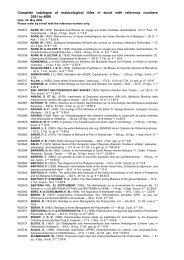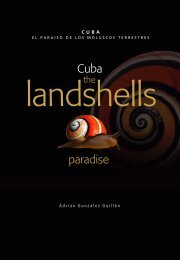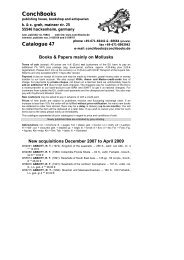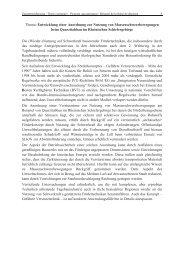Madeira Canary Islands Azores – Fishes Dr. Peter Wirtz
Madeira Canary Islands Azores – Fishes Dr. Peter Wirtz
Madeira Canary Islands Azores – Fishes Dr. Peter Wirtz
You also want an ePaper? Increase the reach of your titles
YUMPU automatically turns print PDFs into web optimized ePapers that Google loves.
Bacallado’s moray (Gymnothorax bacalladoi)<br />
Up to 45 cm long. <strong>Madeira</strong>, <strong>Canary</strong> <strong>Islands</strong>. 5 <strong>–</strong> 20 m depth.<br />
This small moray is only rarely seen. Young animals (like that in the photo) have a light ring behind the head<br />
which disappears in the adult animal. Photo (bottom right) <strong>Peter</strong> <strong>Wirtz</strong>.<br />
26<br />
Conger eels (Congridae)<br />
Conger eel (Conger conger)<br />
Up to 3 m long. <strong>Madeira</strong>, <strong>Canary</strong> <strong>Islands</strong>, <strong>Azores</strong>. 5 <strong>–</strong> 2000 m depth.<br />
The Conger eel differs from the true freshwater eel two pages further on), which can only rarely be seen in the<br />
sea, by having the upper jaw slightly longer than the lower jaw (i.e. the reverse of the freshwater eel). A night-<br />
active species, which hides in dark places during the day. Males reach sexual maturity with 55 - 70 cm length,<br />
females only with 2 m length. Large females can produce up to 8 million eggs. Occasionally, one can see a<br />
conger with circular white rings on the head, the marks of the suction cups of an octopus that tied not to be<br />
eaten by a Conger. Photo <strong>Peter</strong> <strong>Wirtz</strong>.<br />
Garden eel (Heteroconger longissimus)<br />
Up to 60 cm long. <strong>Madeira</strong>, <strong>Canary</strong> <strong>Islands</strong>. 10 <strong>–</strong> 40 m depth.<br />
This tropical species lives on both sides of the Atlantic. In the eastern Atlantic, it reaches its northern limit at<br />
<strong>Madeira</strong> Island (like many other tropical species). The tube in the sand is solidified with a gluey secretion<br />
produced by the tail of the eel. During the day, Garden eels pick drifting plankton out of the water. At night,









